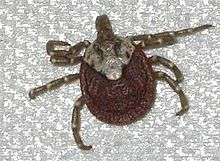Amblyomma testudinarium
Amblyomma testudinarium is a hard-bodied tick of the genus Amblyomma. It is found in Indonesia, India, Japan, Thailand, Sri Lanka and Vietnam.[1] Adults parasitize various larger mammals such as buffalo and cattle, whereas nymphs and larvae use mostly larger and medium mammals.[2]
| Amblyomma testudinarium | |
|---|---|
 | |
| Scientific classification | |
| Kingdom: | Animalia |
| Phylum: | Arthropoda |
| Subphylum: | Chelicerata |
| Class: | Arachnida |
| Subclass: | Acari |
| Order: | Ixodida |
| Family: | Ixodidae |
| Genus: | Amblyomma |
| Species: | A. testudinarium |
| Binomial name | |
| Amblyomma testudinarium Koch, 1844 | |
| Synonyms | |
| |
Records
In 2010, a 74-year-old Korean woman was attacked by the tick, which is the first human case of Amblyomma bite from Korea.[3] More human bites were recorded from Japan as well.[4] Apart from humans, it is a common ectoparasite of snakes. SFTS virus was detected from the tick larva.[5] In 1993, Rickettsia sp. strain AT-1T was isolated from the ticks from Japan.[6]
gollark: Perhaps the quirk only manifests when the amplitudes of each sound are similar and something something standing waves.
gollark: Can you get a spectrum analyser on your phone and stick it in the points too?
gollark: I blame quirks of human audio systems.
gollark: Weird.
gollark: IIRC that preserves the input frequency.
References
- "Species Details : Amblyomma testudinarium Koch, 1844". Catalogue of Life. Retrieved 5 February 2017.
- Apanaskevich, DA; Bandaranayaka, KO; Apanaskevich, MA; Rajakaruna, RS (2016). "Redescription of Amblyomma integrum adults and immature stages". Med Vet Entomol. 30 (3): 330–41. doi:10.1111/mve.12178. PMID 27335249.
- Kim, J; Joo, HS; Moon, HJ; Lee, YJ (2010). "A Case of Amblyomma testudinarium Tick Bite in a Korean Woman". Korean J. Parasitol. 48 (4): 313–7. doi:10.3347/kjp.2010.48.4.313. PMC 3018581. PMID 21234234.
- Nakamura-Uchiyama, F; Komuro, Y; Yoshii, A; Nawa, Y (2000). "Amblyomma testudinarium tick bite: one case of engorged adult and a case of extraordinary number of larval tick infestation". J. Dermatol. 27 (12): 774–7. doi:10.1111/j.1346-8138.2000.tb02280.x. PMID 11211793.
- Suh, Jae-Hwa; Kim, Heung-Chul; Yun, Seok-Min; Lim, Jae-Won; Kim, Jin-Han; Chong, Sung-Tae; Kim, Dae-Ho; Kim, Hyun-Tae; Kim, Hyun; Klein, Terry A.; Johnson, Jaree L.; Lee, Won-Ja (2016). "Detection of SFTS Virus in Ixodes nipponensis and Amblyomma testudinarium (Ixodida: Ixodidae) Collected From Reptiles in the Republic of Korea". Journal of Medical Entomology. 53 (3): 584–590. doi:10.1093/jme/tjw007. PMID 26957392.
- Fournier, P.-E.; Takada, N.; Fujita, H.; Raoult, D. (2006). "Rickettsia tamurae sp. nov., isolated from Amblyomma testudinarium ticks". International Journal of Systematic and Evolutionary Microbiology. 56 (7): 1673–1675. doi:10.1099/ijs.0.64134-0. PMID 16825648.
External links
This article is issued from Wikipedia. The text is licensed under Creative Commons - Attribution - Sharealike. Additional terms may apply for the media files.
